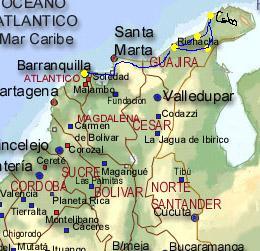
So, at the last minute, I ended up escaping from Barranquilla during our mid-semester break. It was either Cartagena (about an hour to the west) or La Guajira (not nearly as close by). I left Friday morning on a bus to Riohacha, the capital of the state of La Guajira. If you’re looking at a map, it’s the northernmost state in Colombia, right next to Venezuela on the Caribbean coast. It was an interesting ride…you go from Barranquilla, where it’s relatively flat, pass through Santa Marta, which is home of the highest mountains in the country, past Tayrona, where it’s much more tropical and jungle-like, to end up finally in a arid, mirage-making desert.
From Riohacha, our guide with a Land Cruiser, Juan Miguel, managed to squeeze six of us, plus luggage, into one tiny space for a rough two and a half hours to Cabo de la Vela. Along the way we stopped to take pictures of a train (apparently there aren’t many trains in Colombia, because everyone except me was extremely excited by this), the salt flats at Manuare, and a church in a town that is the indigenous center of La Guajira (didn’t catch the name of this one. Past Manuare, the roads were all dirt/sand and very, very rough. By the time we got to Cabo, I felt sick from all the up, down, all over the place driving. The two ladies from Bogotá wanted to see the flamingos, so we sidetracked back through an endless maze of cactus and dry arroyos to the mouth of the river. Not many flamingos since it was the wrong time of day, but lots of other birds. Too bad I didn’t have any binoculars to really see them with. As an indication of what the driving conditions were like, the axle on the Land Cruiser broke on the way back, in the pouring rain. Thank God that we were only a couple of kilometers outside of Riohacha when it happened. Good Samaritanism on the roadside is not such a big thing here, at least from what I’ve seen.
The people at Cabo de la Vela are mostly of indigenous (Wayúu) or mixed backgrounds. There were quite a few who didn’t speak much Spanish, including a few older ladies who cursed at me in their dialect for not buying anything from them. It’s a beautiful place, especially El faro y el Pilón de Azúcar, which I posted pictures of, but very, very isolated.
New words learned: hamaca = chinchorro (update from Monday: No, not really the same. Chinchorros are made with ropes, kinda like fishnets, are less comfortable by far!)
I wanted to sleep in one right by the water, but that didn’t end up happening.
Disturbing things I saw: Locals catching an enormous sea turtle to make soup. I wanted to cry. In Riohacha, beautiful beaches covered with trash. No wonder you don’t have many tourists.
Other things of interest: Roadside “gas stations” (guys with plastic containers full of gas and tubes to put it into the car) near Maicao and the salt flats with “imported” gas from Venezuela.
No comments:
Post a Comment